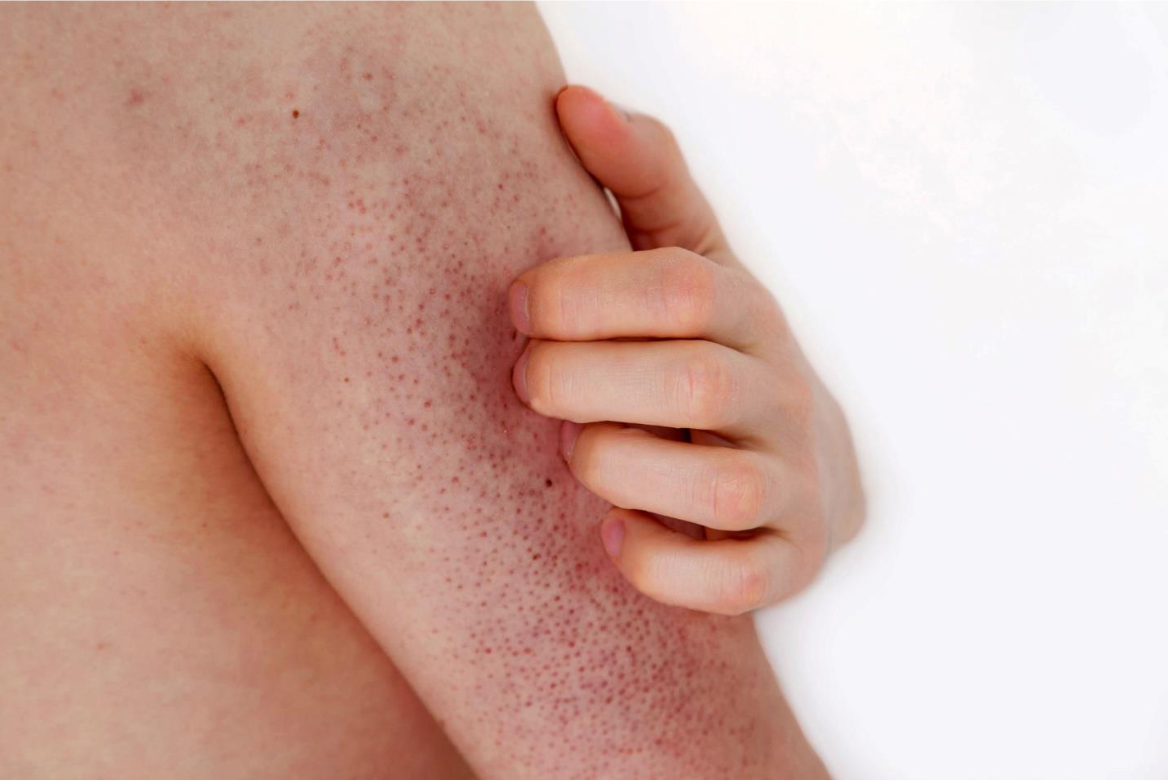Causes and Risk Factors
Keratosis pilaris occurs when keratin—a natural protein that protects the skin—builds up and blocks hair follicles. This leads to the formation of small, rough bumps. Several factors contribute to Keratosis Pilaris, including:
- Genetics: Keratosis Pilaris often runs in families. If one parent has it, there’s a higher chance their children will too.
- Dry Skin: People with naturally dry skin are more prone to Keratosis Pilaris.
- Skin Conditions: Those with eczema (atopic dermatitis) often experience Keratosis Pilaris.
- Age: It is most common during childhood and adolescence but can persist into adulthood.
- Climate: Dry, cold environments can make symptoms worse.
Symptoms and Appearance of Keratosis Pilaris
Keratosis pilaris typically presents as:
- Small, rough, flesh-colored, red, or brown bumps.
- Patches of dry, sandpaper-like skin.
- Bumps that may sometimes become inflamed or slightly itchy.
- Most common on the outer upper arms, thighs, cheeks, and buttocks.
- In some cases, post-inflammatory hyperpigmentation (dark spots) after irritation or scratching.
Keratosis Pilaris is often more noticeable when the skin is dry, such as in winter or in low-humidity climates.
Diagnosis
Dermatologists usually diagnose Keratosis Pilaris based on a simple physical examination of the affected skin. No laboratory tests or biopsies are typically needed unless another skin condition is suspected. Important features that help confirm the diagnosis include:
- Symmetrical distribution of rough bumps.
- Lack of significant redness or open sores unless irritated.
- Chronic, non-contagious nature.
Early diagnosis can reassure patients and guide appropriate skincare management.
How It Differs from Other Skin Conditions
Keratosis pilaris can sometimes be confused with:
- Eczema (Atopic Dermatitis): Eczema presents with red, itchy patches that may ooze, unlike the dry, rough bumps of Keratosis Pilaris.
- Folliculitis: This bacterial infection causes red, swollen, sometimes painful bumps around hair follicles, whereas Keratosis Pilaris bumps are not infected.
- Acne: Acne lesions are larger, inflamed, and often have pus-filled heads, while Keratosis Pilaris bumps are tiny and dry.
Understanding these differences helps in choosing the correct treatment and avoiding unnecessary medications.
Treatment of Keratosis Pilaris
There is no permanent cure for keratosis pilaris, but regular skincare can greatly improve its appearance. Treatments focus on softening the keratin buildup and keeping the skin moisturized. Common options include:
- Moisturizers: Daily use of rich, hydrating creams is essential.
- Keratolytic Agents: Creams containing ingredients like urea, lactic acid, salicylic acid, or glycolic acid help exfoliate the skin and smooth rough patches.
- Gentle Exfoliation: Using soft washcloths or mild exfoliating products can help remove dead skin, but aggressive scrubbing should be avoided.
- Short, Warm Showers: Prolonged hot showers dry the skin and worsen Keratosis Pilaris.
- Humidifiers: Adding moisture to indoor air can prevent the skin from becoming too dry.
Many dermatologists recommend starting with a gentle routine and gradually adding exfoliating treatments as tolerated.
How Metabase Cream Helps
Metabase Cream is an excellent option for managing keratosis pilaris because it addresses multiple underlying issues:
- Barrier Repair: Ceramides in Metabase Cream restore the natural lipids in the skin, strengthening its protective barrier.
- Moisture Retention: Dimethicone forms a breathable layer that locks in hydration without clogging pores.
- Exfoliation and Smoothing: Urea gently exfoliates rough patches and softens hardened keratin plugs.
- Anti-Inflammatory Benefits: Calendula and panthenol help reduce redness and irritation, promoting a calmer, smoother skin appearance.
- Skin Renewal Support: Allantoin enhances cell turnover, allowing healthier, softer skin to surface.
By combining deep hydration with mild exfoliation and skin-calming properties, Metabase Cream helps restore smoothness, comfort, and even skin tone for people struggling with Keratosis Pilaris.
Daily Care Tips
Managing keratosis pilaris requires consistency. Practical daily tips include:
- Apply a suitable cream generously twice daily, especially after bathing.
- Use lukewarm—not hot—water for showers and limit them to 5–10 minutes.
- Avoid harsh soaps; opt for gentle, fragrance-free cleansers.
- Gently pat the skin dry after bathing and immediately apply moisturizer.
- Wear loose, breathable clothing to avoid friction over affected areas.
- Use a humidifier during dry seasons to maintain skin hydration.
Simple lifestyle habits like these make a noticeable difference over time.
When to See a Doctor
Although keratosis pilaris is harmless, consult a dermatologist if:
- The bumps become painful, severely inflamed, or infected.
- The skin shows signs of scarring or discoloration.
- Over-the-counter treatments do not improve the appearance after a few months.
- The condition causes significant self-consciousness or emotional distress.
Professional advice can help tailor advanced treatment plans, including prescription creams or in-office therapies.
Conclusion
Keratosis pilaris is a very common, harmless skin condition that can be managed effectively with consistent skincare. Gentle exfoliation, deep hydration, and the use of appropriate skincare products can significantly smooth the skin’s texture and improve confidence. With patience and a simple daily routine, most people see noticeable improvements over time.
Say goodbye to chicken skin and enjoy smoother, clearer skin with Metabase Cream.
Try Metabase today!
